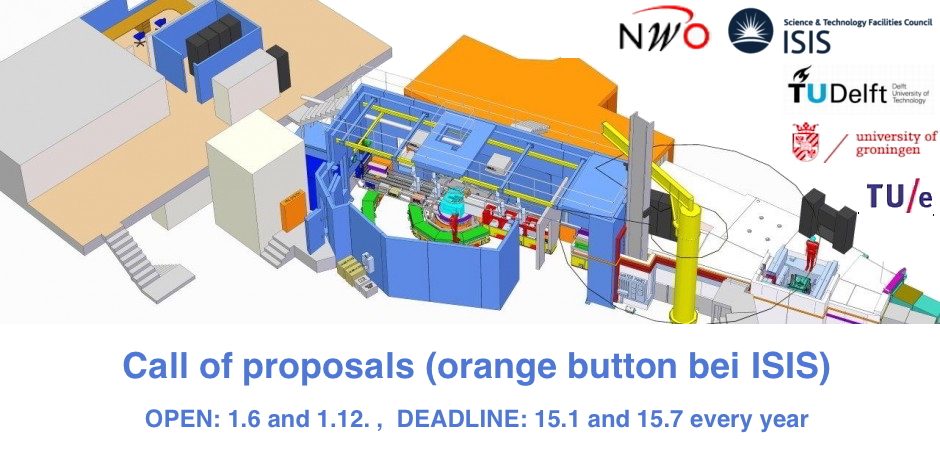The strength of neutrons in soft matter investigations lies in the direct sensitivity to the relevant time and length scales as well as in the ability to distinguish between hydrogen and deuterium, the so-called contrast variation method. The SANS, SESANS, NRSE and MISANS modes situate LARMOR in the most relevant parameter space for soft matter studies. Moreover, Dutch soft matter science with its strong position in polymers, membranes, colloids and biology will benefit from LARMOR. In the following we will discuss the impact LARMOR will have on three important fields of soft-matter research relevant to Dutch scientists: colloids, complex molecular systems, and food materials.
The fundamental physical chemical research on interactions between nanoparticles in solution, such as colloidal suspensions and micro emulsions, form the basis for many industrial applications ranging from water-based paint to ink for ink-jet printers or oil-water systems for oil recovery. It is also a starting point for the description of complex molecular systems and food materials. The stability, structure and phase behavior of these suspensions depends on the balance between the different interactions such as excluded volume, electrostatic, hydrophobic or depletion and this equilibrium. By tuning the interactions, through proper choice of colloids, salt concentration, pH or by adding polymers, and investigating the resulting structures by light, X-Ray or neutron scattering, it is possible to have a targeted design of colloidal structures. In this field contrast variation can be exploited to studying e.g. depletion, which when adding non-adsorbing polysaccharide to the solution, may result in long-range attraction between proteins. SESANS was used to investigate a suspension of sterically stabilised 300-nm-diameter silica particles in cyclohexane, showing that the hard-sphere theory (Percus-Yevick with Henderson-Grundke correction) describes the data for the high-density phase. These studies will be pursued on LARMOR by the groups of Eindhoven University of Technology, Wageningen University and DSM.
Complex molecular systems
This field comprises supra molecular chemistry description, analysis, and synthesis of complexes of several (macro) molecules and their properties, such as self-assembly and phase behavior and is narrowly linked to nanotechnology. The resulting man-made assemblies have a wide variety of applications from sensors, light harvesting materials to drug delivery systems. Micelles formed by electrostatically driven assembly of oppositely charged components are relatively novel self-assembling systems. The resulting particles are termed complex coacervate core micelles (C3Ms) and SANS is a useful tool to investigate their structure.
In addition virus protein-based assemblies find increasing applications in the formation of (functional) nanostructures. In this emerging field, sometimes referred to as chemical virology, spherical viruses are used as containers to direct or confine mineralization or as nanoreactors when enzymes are encapsulated and SANS is a
unique tool for determining the structures.
This sub-section also includes photonic single crystals the spatial and magnetic structure of which will be studied by the polarised SANS and SESANS modes of LARMOR shows microradian X-ray diffraction from these systems, which recently were also assembled in a magnetic version, in a so-called magnonic crystal. On LARMOR these studies will be pursued by the groups of Eindhoven University of Technology, Radboud University, University of Twente and Utrecht University.
Food materials
Food research plays a prominent role in the top sector ‘Life science and health’. One of the aims is to produce
healthier food, e.g. with ingredients that will decrease human cholesterol levels, lower the risk of cancer, or even
have therapeutical effects. Furthermore, new low-fat products, such as cream cheese and margarines are developed that should be stable under frequently varying temperatures. Wageningen University, Unilever and NIZO plan to use LARMOR. More industries and university labs showed their interest through the Top Institute for Food and Nutrition.
The structure of casein micelles in milk have been extensively studied using small-angle neutron. Using both light
scattering and SANS Huppertz et al. studied the stability of internally cross-linked casein micelles. This may offer potential applications for the use of crosslinked casein micelles as biocompatible protein micro-gel particles. SESANS showed the aggregation mechanism of these casein micelles during yoghurt formation. The effect of processing conditions of microgels (model system for fresh cheese) was measured with SESANS. Neutron scattering combined with H/D substitution has been applied to determine the hydrogen bond structure in glassy and liquid glucose. A Future project that will make optimum use of LARMOR is the determination of a new type
of margarine, a water/oil emulsion stabilised by supramolucular fibres. Then, all relevant length scales will be probed.


